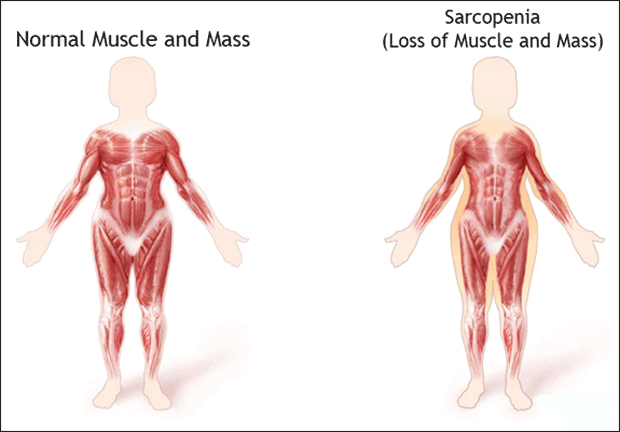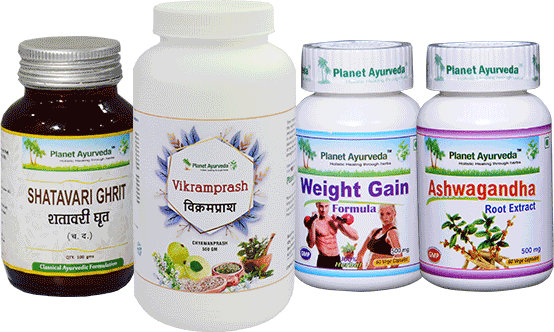What is Sarcopenia? – Causes, Symptoms and Ayurvedic Treatment
Abstract
The normal aging process causes sarcopenia, which is the loss of muscular mass. A person’s strength is reduced when their muscular mass decreases. As a consequence of this, their balance and gait are also altered. Sarcopenia may make it difficult for a person to do things like climb stairs, lift items, or walk. Ayurveda is a beautiful system of medicine that not only heals sickness but also keeps our bodies healthy and balanced. Sarcopenia may be treated using a variety of herbs and herbal formulae that can keep you feeling energetic, youthful, and healthy far into your senior years.
Introduction
Sarcopenia is an aging disorder. Sarcopenia does not have to occur since aging is an inescapable and normal process. However, our sedentary lifestyles and disregard for our health have resulted in aging issues such as sarcopenia. Your stride, balance, and general ability to accomplish everyday duties are all impacted by sarcopenia. This condition mostly affects the elderly and may result in physical handicaps, decreased quality of life, and death in certain instances.

Causes
Sarcopenia is often caused by a lack of physical activity throughout the day. Sarcopenia may also be seen in people who lead busy lifestyles, although it is less prevalent. This suggests that the disease’s onset might have been caused by other reasons as well. Other reasons for sarcopenia usually involve a decline in nerve cells that transmit messages from your brain to notify your muscles to work, a drop in hormone levels, a decrease in your body’s capacity to transform protein to energy, and not eating adequate daily calories and protein to maintain muscle mass.
Symptoms
The severity of sarcopenia symptoms varies according to how much muscle mass has been lost. Signs also include:
- Exhaustion
- A reduction in muscle size and weakness
- Climbing the stairs is difficult.
- Inequity
Factor of Risk
Although age is the most common cause of sarcopenia, other variables also play a role in muscle loss. Here are a few examples:
- Consuming too few vegetables and fruits, as well as eating a lot of acid-producing foods like grains and processed meals, may lead to a loss of muscle mass.
- People who engage in little or no physical exercise on a daily basis are more likely to develop sarcopenia as they get older.
- Malnutrition is a risk for older people who eat less. According to the International Organization for Research on Cancer, up to 41% of women and 38% of men over 50 consume less protein than the daily recommended limit.
- Sarcopenia may be exacerbated by poor nutrition. Poor diet may impact how quickly muscle mass falls in elderly people, even though it can happen at any age.
Prevention
- The most prevalent cause of this affliction is a lack of exercise. As a result, maintaining a healthy level of physical activity may reduce your risk of developing sarcopenia. Even a half-hour of moderate activity every day, such as walking or running, can assist maintain your system in good shape.
- Whey protein is a kind of protein that aids in the preservation of muscle mass.
- A proper diet is also necessary for successful activity. Research According to Trusted Source, eating extra protein may lessen the risk of sarcopenia in older people. Supplements have also been shown to help prevent sarcopenia.
Which treatment is better for you?
There are currently no allopathy-approved drugs to treat sarcopenia. However, as previously said, we have exclusive control over the treatment choice, therefore we must make informed decisions. Treatment with Ayurvedic medicine is a good choice. Sarcopenia may be treated using a variety of herbs and herbal combinations. Only pure and natural herbs are used in herbal formulations, and Planet Ayurveda has the most effective herbal formulations for sarcopenia.
Everything you need to know about Planet Ayurveda
Planet ayurveda is GMP certified Company offering herbal products across all over the world. These products are 100 % safe and prepared under the guidance of expert ayurveda physicians by following classical ayurvedic texts. There are lots of products for sarcopenia, some of them are listed below

1. Ashwagandha Capsules
In Ayurveda, Ashwagandha has a lot of medicinal value and provides a lot of health advantages. Ayurveda considers this plant to be a revitalizing herb. Anti-aging, anti-inflammatory, and adaptogenic effects are all present in this plant. It aids in the growth and strength of muscles. It has an Ashwagandha herbal extract that is pure and standardized (Withania somnifera).
Dosage: 2 capsules twice a day, after meals, with plain water
2. Weight Gain formula
This Planet Ayurveda weight gain solution promotes endurance, stamina, and raises a person’s weight. Because of sarcopenia, muscle weight grows and the body fat-to-muscle ratio remains constant. Some of the substances that may help us against the symptoms of sarcopenia are Ashwagandha (Withania somnifera), Vidanga (Embelia ribes), Haritaki (Terminalia chebula), Amalaki (Phyllanthus emblica), and Pippali (Piper longum).
Dosage: After meals, take 1-2 capsules with plain water twice a day.
3. Vikramprash
It maintains the equilibrium of the doshas (body energies), dhatus (body tissues), and malas (diseases) using herbs such as Bilva (Aegle marmelos), Kashmarya (Gmelina arborea), and Bala (Sida cordifolia) (body waste). This is how it may assist you in overcoming sarcopenia’s effects.
Dosage: Take 1-2 teaspoonfuls twice to three times a day, ideally with milk.
4. Shatavari Ghrit
Shatavari Ghrit is an Ayurvedic treatment in the form of ghee. This drug assists people with sarcopenia by harmonizing the vata and pitta doshas in their bodies. Among the ingredients are shatavari (Asparagus racemosus), meda (Polygonatum cirrhifolium), kakoli (Lilium polyphyllum), and other plants.
Dosage: 1-2 tsp mixed with Mishri, or as directed by your doctor.
Contact my assistant to provide you the costing / ordering and delivery information at – costing.planetayurveda@gmail.com or call at +91-172-5214040
Conclusion
From complete information, it is concluded that treatment which not only provides us relief from the disease, but also various health benefits without side effects is the best, so overall Ayurvedic treatment is the best. Ayurvedic treatment by Planet Ayurveda is safe and effective. Therefore, adopt this Ayurvedic treatment for sarcopenia and keep yourself healthy even in old age.





